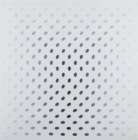
Nineteen Greys C

Nineteen Greys C
Signed Print
Bridget Riley
£6,500-£9,500
$13,000-$19,000 Value Indicator
$12,000-$18,000 Value Indicator
¥60,000-¥90,000 Value Indicator
€7,500-€11,000 Value Indicator
$70,000-$100,000 Value Indicator
¥1,350,000-¥1,970,000 Value Indicator
$8,500-$12,500 Value Indicator
There aren't enough data points on this work for a comprehensive result. Please speak to a specialist by making an enquiry.
76 x 75cm, Edition of 75, Screenprint
Auction Results

Track auction value trend
Meaning & Analysis
Nineteen Greys C is the third in a series of four screen prints executed by Bridget Riley in 1968. In this series, the principle of regularity is expressed overtly in a grid system of equal intervals. The ovals comprising the grid system are facing varying angles, creating a sense of movement that ripples across the surface.
In Nineteen Greys C, the grey hue of each oval darkens in tone towards the lower centre of the composition. In each print, the directional flow of the tones is at a slight variance with the angles and structure of the grid. In this instance, the edges of the composition appear to blur out of focus, as our eyes are drawn to the darker grey tones concentrated in the middle.
This series embodies a committed exploration into the formal qualities of painting: form, shape and colour, which Riley has remained committed to throughout her career. The introduction of grey also marks an important moment in the artist’s career, just before a full spectrum of colour was to be introduced in the 1970s.